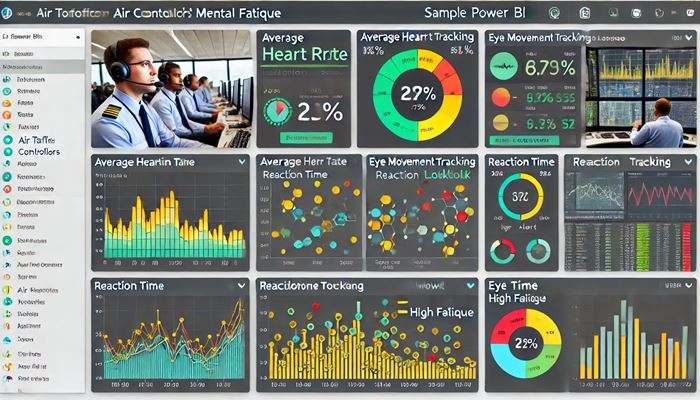Monitoring Air Traffic Controllers’ Mental Fatigue with Power BI: A Business Intelligence Approach
In the aviation industry, air traffic controllers (ATCs) play a critical role in ensuring safe and efficient flight operations. However, the high demands of their job can lead to mental fatigue, which directly impacts their performance. Monitoring mental fatigue is vital for maintaining safety and operational efficiency in air traffic management. This article explores how Power BI, a robust Business Intelligence (BI) tool, can be used to monitor and analyze ATCs’ mental fatigue, offering data-driven insights for better decision-making.
The Importance of Mental Fatigue Monitoring in Air Traffic Control
Air traffic control is a high-stress occupation, requiring sustained concentration, quick decision-making, and precise communication. Mental fatigue in ATCs can lead to delayed responses, increased errors, and compromised safety. Traditionally, fatigue has been monitored through self-reports or occasional assessments, which can be subjective and infrequent. By leveraging real-time data analytics through Power BI, aviation management can track fatigue levels more accurately and consistently, ensuring timely interventions and minimizing risks.
“Air Traffic Controller Fatigue: A Review of Academic Publications“
Objectives of the BI Project
- To continuously monitor mental fatigue in ATCs.
- To analyze patterns and trends in fatigue levels over time.
- To provide actionable insights for operational and human resource management.
Data Sources for Mental Fatigue Monitoring
To monitor mental fatigue effectively, various data sources can be integrated into Power BI. These include:
- Shift schedules and workload data: Longer shifts and peak traffic periods can increase fatigue.
- Physiological indicators: Data such as heart rate variability, EEG readings, and eye movement can offer insights into real-time mental fatigue.
- Self-reported fatigue levels: Surveys and daily logs from controllers can complement physiological data.
- Operational data: Flight movements, delays, and ATC error rates can be tracked for potential correlations with fatigue levels.
Combining these data sources into a centralized BI dashboard allows for real-time tracking and detailed analysis.

Using Power BI for Mental Fatigue Monitoring
Power BI is an ideal tool for this type of BI project due to its ability to handle complex data and present it in an intuitive, interactive format. Here’s how Power BI can be leveraged for monitoring ATCs’ mental fatigue:
1. Data Integration
Power BI allows integration of multiple data streams, both structured and unstructured, from internal systems like workload databases and external sources like wearable devices. These streams are essential to create a holistic view of each ATC’s workload and fatigue levels.
2. Real-time Dashboards
Through Power BI’s real-time dashboards, aviation supervisors can monitor key fatigue indicators such as:
- Number of flights handled per shift.
- Time spent on radar.
- Physiological stress markers.
- Shift duration and break intervals. This enables the identification of fatigue risks as they emerge, allowing immediate corrective actions.
3. Trend Analysis and Predictive Analytics
Power BI’s advanced analytics capabilities enable organizations to spot long-term trends in mental fatigue. By applying predictive algorithms, Power BI can forecast fatigue levels based on past workload data, shift patterns, and physiological indicators. This allows ATC supervisors to adjust work schedules and manage controller rotations proactively, preventing severe fatigue before it happens.
4. Customizable Alerts and Notifications
Power BI offers the ability to set up real-time alerts. For instance, if an ATC’s mental fatigue reaches a predefined threshold based on physiological data, supervisors can receive instant notifications to initiate fatigue management protocols, such as scheduling a break or adjusting the workload.
5. Drill-down Reports
Managers can use Power BI’s drill-down feature to move from high-level trends to individual ATC reports. This capability helps pinpoint which controllers are at higher risk and identify the operational factors contributing to increased fatigue, such as long periods of high-intensity traffic.
The Role of AI and Machine Learning in Enhancing BI Insights
AI and machine learning (ML) can enhance Power BI’s capabilities by automating fatigue pattern detection and offering predictive insights. For example, ML models can analyze the correlation between high workload periods and physiological fatigue indicators. These models can then adjust fatigue forecasts in real time, improving the accuracy of BI reports.
AI algorithms can also assess complex datasets to offer recommendations, such as optimal shift schedules that minimize fatigue while ensuring operational efficiency. This helps management make data-driven decisions, enhancing overall air traffic control safety.
Business Benefits of Using Power BI for Fatigue Monitoring
Implementing Power BI as a mental fatigue monitoring tool offers several business advantages:
1. Enhanced Safety
By identifying fatigue early, organizations can take corrective actions that reduce the likelihood of human errors, thus improving overall safety in air traffic management.
2. Operational Efficiency
Monitoring fatigue helps avoid overloading ATCs, which can lead to more efficient traffic management and fewer delays. It ensures that controllers are mentally sharp during high-stakes operations, enhancing decision-making speed and accuracy.
3. Reduced Costs
Preventing fatigue-related incidents can reduce costs associated with accidents, delays, and employee turnover. Power BI’s real-time insights enable organizations to optimize staff scheduling, reducing the need for overtime and minimizing operational disruptions caused by fatigue-related errors.
4. Data-Driven Human Resource Management
By analyzing fatigue trends, HR teams can design better support programs for ATCs, improving employee satisfaction and retention. This also provides data to advocate for necessary policy changes or investments in additional staffing during peak periods.
Challenges and Considerations
While Power BI offers significant benefits for fatigue monitoring, there are challenges to consider. Data privacy is a critical issue, as collecting physiological data could raise concerns among employees. Ensuring that data is anonymized and handled according to privacy regulations is crucial.
Moreover, the success of this BI project depends on the quality and reliability of the data collected. Inconsistent data from wearables or incomplete workload information can lead to inaccurate insights. Therefore, robust data collection protocols must be in place.
Conclusion
Monitoring mental fatigue in air traffic controllers is not just a safety measure but a strategic business decision. Using Power BI to monitor fatigue provides real-time insights, enabling proactive management and data-driven decision-making. By leveraging data from various sources and employing AI-driven analytics, aviation organizations can enhance safety, operational efficiency, and employee well-being. This approach underscores the growing importance of Business Intelligence tools like Power BI in optimizing complex, high-stakes industries like air traffic control.
Implementing a BI project with Power BI for fatigue monitoring aligns with both business goals and safety requirements, making it an invaluable tool in the modern aviation landscape.


